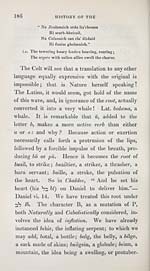Download files
Complete book:
Individual page:
Thumbnail gallery: Grid view | List view

CELTIC LANGUAGE. 187
ance of Nature. This is a povverful, orderly, and
natural militia of evidence, in which the thoughtful
and intelhgent reader wiU see the origin of Lan-
guage, the spread of Thought, the progress of
Mind, and the use of analogy imàjìrjure.
" A' stoc 's a meanglain le chuile,
'Siad ag èiridh mar a b'abhaist."
Of the Character C.
The power of C in the Celtic alphabet is Kè or
Ek, Kà or A7. It is never soft like s. It is a
sound naturally produced in tossing or throwing a
heavy body, in which case the root of the tongue
is fìxed so as to close up the interior of the mouth,
and so assist Nature. When the exertion is over,
the breath issues with a sudden impulse, producing
the sound càh or kàh: hence càh or cà, to throw,
toss as a stone or javelin; cah or cath, a battle,
a fight, a contest. It is expressive, of course, of
the primitive mode of fighting. So Milton, on the
murder of Abel: —
" Whereat he (Cain) inly raged, andas they talked,
Smotc him in the midritf with a stone
That beat out ììt'e."
And Homer: —
" A hroken rock the force of Pirus threw,
Who from cold Acnus led the Thracian crew,
Full on his ankle dropt the pond'roiis stone,
Burst the strong nerves, and crash'd the solid bone."
ance of Nature. This is a povverful, orderly, and
natural militia of evidence, in which the thoughtful
and intelhgent reader wiU see the origin of Lan-
guage, the spread of Thought, the progress of
Mind, and the use of analogy imàjìrjure.
" A' stoc 's a meanglain le chuile,
'Siad ag èiridh mar a b'abhaist."
Of the Character C.
The power of C in the Celtic alphabet is Kè or
Ek, Kà or A7. It is never soft like s. It is a
sound naturally produced in tossing or throwing a
heavy body, in which case the root of the tongue
is fìxed so as to close up the interior of the mouth,
and so assist Nature. When the exertion is over,
the breath issues with a sudden impulse, producing
the sound càh or kàh: hence càh or cà, to throw,
toss as a stone or javelin; cah or cath, a battle,
a fight, a contest. It is expressive, of course, of
the primitive mode of fighting. So Milton, on the
murder of Abel: —
" Whereat he (Cain) inly raged, andas they talked,
Smotc him in the midritf with a stone
That beat out ììt'e."
And Homer: —
" A hroken rock the force of Pirus threw,
Who from cold Acnus led the Thracian crew,
Full on his ankle dropt the pond'roiis stone,
Burst the strong nerves, and crash'd the solid bone."
Set display mode to: Large image | Transcription
Images and transcriptions on this page, including medium image downloads, may be used under the Creative Commons Attribution 4.0 International Licence unless otherwise stated. ![]()
| Early Gaelic Book Collections > Hew Morrison Collection > Adhamh agus Eubh, no Craobh Sheanachais nan Gàël > (317) |
|---|
| Permanent URL | https://digital.nls.uk/76900529 |
|---|
| Description | A selection of items from a collection of 320 volumes and 30 pamphlets of literary and religious works in Scottish Gaelic. From the personal library of Hew Morrison, the first City Librarian of Edinburgh. |
|---|
| Description | Selected items from five 'Special and Named Printed Collections'. Includes books in Gaelic and other Celtic languages, works about the Gaels, their languages, literature, culture and history. |
|---|

